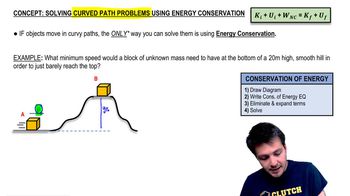10. Conservation of Energy
Motion Along Curved Paths
Practice this topic
- Textbook Question
A ball is attached to a horizontal cord of length ℓ whose other end is fixed, Fig. 8–45.
(a) If the ball is released, what will be its speed at the lowest point of its path?
<IMAGE>
234views - Textbook Question
A ball is attached to a horizontal cord of length ℓ whose other end is fixed, Fig. 8–45.
(b) A peg is located a distance h directly below the point of attachment of the cord. If h = 0.80ℓ, what will be the speed of the ball when it reaches the top of its circular path about the peg?
<IMAGE>
440views - Textbook Question
The small mass m sliding without friction along the looped track shown in Fig. 8–47 is to remain on the track at all times, even at the very top of the loop of radius r.
(a) In terms of the given quantities, determine the minimum release height h.
<IMAGE>
268views - Textbook Question
The small mass m sliding without friction along the looped track shown in Fig. 8–47 is to remain on the track at all times, even at the very top of the loop of radius r.
(b) If the actual release height is 2h, calculate the normal force exerted by the track at the bottom of the loop, then
298views

